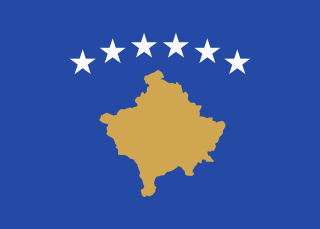
Kosovo, officially the Republic of Kosovo, is a country in Southeast Europe with partial diplomatic recognition. Kosovo lies landlocked in the centre of the Balkans, bordered by Serbia to the north and east, North Macedonia to the southeast, Albania to the southwest, and Montenegro to the west. Most of central Kosovo sits on the plains of Metohija and the Kosovo field. The Accursed Mountains and Šar Mountains rise in the southwest and southeast, respectively. Kosovo's capital and largest city is Pristina.

Prizren is the second most populous city and municipality of Kosovo and seat of the eponymous municipality and district. It is located on the banks of the Prizren River between the foothills of the Sharr Mountains in southern Kosovo. Prizren experiences an oceanic climate under the influence of the surrounding mountains.

A municipality is the basic administrative division in Kosovo and constitutes the only level of power in local governance. There are 38 municipalities in Kosovo; 27 of which have an Albanian ethnic majority, 10 Serb and 1 Turkish. After the 2013 Brussels Agreement, signed by the governments of Kosovo and Serbia, an agreement was made to create a Community of Serb Municipalities, which would operate within Kosovo's legal framework. Since 2013, the agreement has not been fulfilled by Kosovo's authorities, calling upon its constitution and territorial integrity.
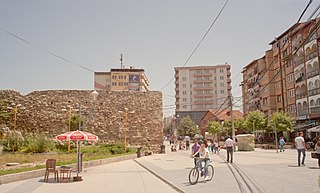
Vushtrri is a city and municipality located in the Mitrovica District in northern Kosovo. According to the 2011 census, the town of Vushtrri has 26,964 inhabitants, while the municipality has 69,870 inhabitants. Vushtrri is surrounded by the city of Mitrovica to the north, Podujevo in the east, Obiliq in the south, Drenas in the south-west, and Skenderaj in the west. The municipality of Vushtrri has 67 villages.
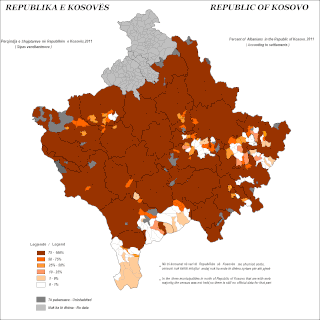
The Albanians of Kosovo, also commonly called Kosovo Albanians, Kosovan Albanians or Kosovars, constitute the largest ethnic group in Kosovo.

Mehdi Bardhi was a Kosovar linguist, author, and teacher.
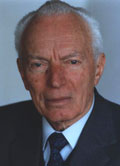
Mark Krasniqi was an Kosovar Albanian ethnographist, publicist, writer and translator who did most of his work while residing in Yugoslavia.
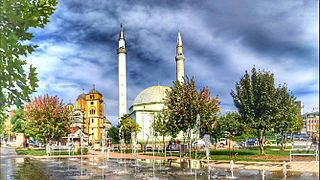
Ferizaj or Uroševac, is a city and a municipality in Kosovo. It is the sixth largest city in Kosovo by population and also the seat of Ferizaj Municipality and the Ferizaj District.
Selman Riza (1909–1988) was an Albanian linguist and Albanologist. Riza was one of the founding members of the Albanological Institute of Pristina in 1953.
Classical music in Kosovo refers to the art music cultivated in Kosovo. The roots of classical music in Kosovo are found in the 1940s and include the time period from the times when Kosovo was part of Yugoslavia to this day. It can be said that there is a tradition of classical music in Kosovo, however, compared to other Balkan countries and especially European countries this tradition is younger. Classical music in Kosovo reaches back about 70 years. Even though in a short period of time, this music has evolved, passing through generations of composers and artists. In his book Albanian: Zhvillimi i stileve në veprat e kompozitorëve shqiptarë të Kosovës, Engjëll Berisha comments:
"The diversity of styles in Albanian music [of Kosovo], its national patterns with sound idea-aesthetic foundations are a characteristic of the European musical reality, so many many works are of interest abroad, too, because during this relatively short period Albanian classical music in Kosovo has compensated for the delay in its development."
Theatre in Kosovo like the culture of Kosovo is a dual tradition.

Sami Frashëri High School is a selective entry gymnasium with two campuses located on the same street in the Qendër neighborhood of Pristina, Kosovo. The school is highly regarded for academics. The school is among the oldest in Prishtina and Kosovo, and it holds the name of the writer, philosopher, playwright and prominent figure of the Albanian Renaissance Movement, Sami Frashëri.

Education in Peja, Kosovo is a based on a system with no tuition fees, mandatory for all children between ages 6 and 18. It consists of a nine-year basic comprehensive school, secondary general and professional education commonly known as high school, and higher education (university). It also includes non-mandatory daycare programs for babies and toddlers, and a one-year "preschool". The school year runs from early September to late June of the following year. Winter break runs from late December to early January, dividing the school year into two semesters.

Education in Gjilan includes primary, secondary education, and a public university. In 2018, the Organization for Security and Co-operation in Europe estimated that there were 18,370 students enrolled in kindergarten, primary and secondary educational institutions in Gjilan.
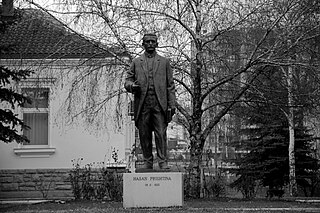
Education in Pristina, the capital of Kosovo, consists of primary, secondary and higher education. Pristina houses a number of public and private institutions, such as the University "Hasan Prishtina", the National Library of Kosovo, and the Academy of Sciences and Arts of Kosovo. Throughout the last century Pristina has attracted a considerable number of students from Kosovo. Today, the city of Pristina hosts a large number of intellectuals, professors, academics, students, and professionals in various spheres.

The Kosovo Agency of Statistics monitors various demographic features of the population of Kosovo, such as population density, ethnicity, education level, health of the populace, economic status, religious affiliations and other aspects of the population. Censuses, normally conducted at ten-year intervals, record the demographic characteristics of the population. According to the first census conducted after the 2008 declaration of independence in 2011, the permanent population of Kosovo had reached 1,810,366.

Education in Kosovo is carried out in public and private institutions. Starting from 1999, education in Kosovo was subject to reforms at all levels: from preschool education up to university level. These reforms aimed at adjusting the education in Kosovo according to European and global contemporary standards. As a first step of this new system is considered the establishment of the Department of Education and Science (DES), which is followed with the creation of legal and professional infrastructure, which should facilitate the fundamental reformation of the education, and the establishment of the Ministry of Education, Science and Technology (MEST) in March 2002. During this period the private education system began to develop.
Pajazit Nushi was a university professor, psychologist and scientific and social-political worker from Gjakova, Kosova. Member of the Academy of Sciences and Arts of Kosovo.
Zef Mirdita was an Albanian historian, university professor and academic from Prizren, Kosovo. He has made a significant contribution to the fields of Illyrology and Balkan studies.

Luciano Motroni was a general surgery physician who made a significant contribution in the field of education and professional advancement of medical personnel in Prizren, Kosovo.





















